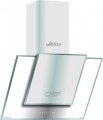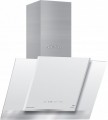Flow of air (motor)
The maximum flow of air or motor flow of air indicates the theoretical capability of the device. This parameter of the hood (motor) is measured during idle operation. By connecting the duct and working in the appropriate mode of extraction, the flow of air will be lower. However, high-performance motors will also give a high flow of air in extraction mode.
Grease filter
The type of grease filter normally used in the hood. Usually, it has the appearance of a fine mesh that traps drops of fat and kitchen fumes. The grease filter can be like this:
— Metal. In this case, different materials can be used; most often, the word "metal" means a filter made of a relatively inexpensive alloy, and aluminium and stainless steel are usually listed separately (see below for more details). Common features of metal mesh are strength, durability and reusability: it is enough to wash and dry a dirty filter, after which it is ready for use again.
— Aluminium.
Filters made of aluminium alloys are considered to be very durable, because this material is highly resistant to corrosion. However, such filters are noticeably more expensive than ordinary metal ones (see above).
—
Stainless steel. Mesh made of this material has all the advantages of the metal filters described above; they are very reliable and durable, but at the same time not cheap. As a result, the use of stainless steel is typical mainly for premium hoods.
— Acrylic. A polymeric material similar to plastic. The main and the only advantage of acrylic filters is their low cost. At the same time, their service life is much shorter than that of metal ones. And some of these filters are generally disposable and cannot be cleaned after clogging. As a result, such filters are used mainly in low
...-cost models of hoods, and even then quite rarely.Lighting
Lighting method provided as standard in the hood.
— Incandescent lamp. The simplest and most affordable of modern lighting sources. The main advantage of incandescent lamps is their low cost. In addition, they give a fairly eye-pleasing light in warm colours. On the other hand, such lamps are the most energy-intensive. Besides, they get very hot during operation.
— Halogen lamp. An improved version of the incandescent lamps described above. They are distinguished by higher brightness at lower power consumption while also having a spectrum of luminescence that is pleasing to the eye. At the same time, halogen lamps are still inferior in terms of efficiency to fluorescent and LED lamps.
— Fluorescent lamp. Also known as "fluorescent light bulbs" or "energy-saving light bulbs". One of the advantages of such lamps is just low power consumption — many times lower than that of incandescent lamps (although higher than that of LEDs). The light from fluorescent lamps is white, rather cold; this can be both an advantage and a disadvantage, depending on personal preferences and interior features. But of the unambiguous shortcomings, it is worth noting that most of these lamps contain mercury vapour in the flask; because of this, failed light bulbs must be disposed of according to special rules, and a broken lamp can become a source of health problems.
—
Light-emitting diodes (LED). The most advanced of mod
...ern lighting sources. LEDs are highly energy-efficient. They are more economical than incandescent lamps, and they practically do not heat up during operation. The light from such sources is neutral white, which is quite suitable for most cases. The disadvantage of LEDs is a rather high price.
Note that many modern hoods allow you to replace a regular light source — for example, a halogen lamp can be changed to a fluorescent or LED lamp with the same base.Duct diameter
The duct diameter characterizes the size of the hood outlet to which the ducts are connected. The standard is either
120 mm or
150 mm. In many cases, an adapter from one diameter to another can additionally be included with the device. However, when replacing the hood with a new one, it is still better to operate with the existing pipe diameter and not use adapters.
Height (min)
The minimum height of the entire hood structure is from the lower edge to the upper part of the body (the point of connection of the external air duct). This parameter is indicated only for hoods with an adjustable design that allows you to change the height. Pay special attention to the minimum height if the device is planned to be installed in a kitchen with a low ceiling. In this case, it should be assumed that the optimal height of the air intake above the hob is 60-80 cm, and between the hood body and the ceiling, a headroom is required for the air duct. With a low ceiling, a hood that is too large may simply not fit into your kitchen.
Height (max)
The height of the entire hood structure is from the lower edge to the upper part of the body (the point of connection of the external air duct). For hoods with an adjustable design that allows you to change the height of the case, the maximum height is the size of the device in the unfolded state; in the case of non-adjustable hoods, this means a correspondingly constant overall height. When choosing a hood in height, it is worth proceeding from two points:
1. The optimal height of the air intake above the hob is 60-80 cm. This height allows the hood to capture kitchen fumes effectively and, at the same time, gives enough space to work with the hob.
2. Between the hood body and the ceiling, a clearance is required for connecting an external air duct.

